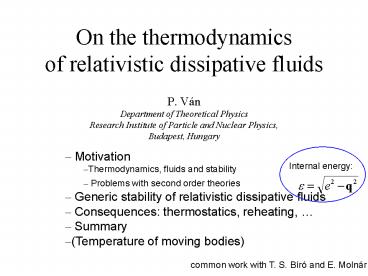On the thermodynamics of relativistic dissipative fluids - PowerPoint PPT Presentation
Title:
On the thermodynamics of relativistic dissipative fluids
Description:
On the thermodynamics of relativistic dissipative fluids P. V n Department of Theoretical Physics Research Institute of Particle and Nuclear Physics, – PowerPoint PPT presentation
Number of Views:152
Avg rating:3.0/5.0
Title: On the thermodynamics of relativistic dissipative fluids
1
On the thermodynamics of relativistic
dissipative fluids
- P. Ván
- Department of Theoretical Physics
- Research Institute of Particle and Nuclear
Physics, - Budapest, Hungary
- Motivation
- Thermodynamics, fluids and stability
- Problems with second order theories
- Generic stability of relativistic dissipative
fluids - Consequences thermostatics, reheating,
- Summary
- (Temperature of moving bodies)
common work with T. S. Bíró and E. Molnár
2
Stability and Second Law
Entropy Lyapunov function
Homogeneous systems (equilibrium
thermodynamics) dynamic reinterpretation
ordinary differential equations clear,
mathematically strict See e.g. Matolcsi, T.
Ordinary thermodynamics, Academic Publishers, 2005
3
Continuum systems
partial differential equations Lyapunov
theorem is more technical
Linear stability (of homogeneous equilibrium)
Example non-relativistic fluid mechanics
local equilibrium, Fourier-Navier-Stokes
n particle number density vi relative
(3-)velocity e internal energy density qi
internal energy (heat) flux Pij pressure ki moment
um density
Thermodynamics
p
4
Fourier-Navier-Stokes
Isotropic linear constitutive relations, ltgt is
symmetric, traceless part
Equilibrium
Linearization, , Routh-Hurwitz criteria
Thermodynamic stability (concave entropy)
Hydrodynamic stability
5
Dissipative relativistic fluids
Nonrelativistic Relativistic Local
equilibrium FourierNavier-Stokes Eckart
(1940) (1st order) Beyond local
equilibrium Cattaneo-Vernotte, Israel-Stewart
(1969-72), (2nd order) gen. Navier-Stokes
Müller-Ruggieri, etc Geroch,
Pavon-extended, Öttinger, Carter, etc.
Eckart (light) Israel-Stewart
order estimates
6
Stability conditions of the Israel-Stewart theory
(Hiscock-Lindblom 1985)
7
Remarks The Israel-Stewart theory is not
proved to be symmetric hyperbolic. In
Israel-Stewart theory the symmetric hyperbolicity
conditions of the perturbation equations follow
from the stability conditions. Israel-Stewart
theory is one of the best investigated theories
from the point of view of stability and
hyperbolicity. Every Israel-Stewart coefficient
is calculated only for ideal Boltzmann gases (by
Israel and Stewart). Some coefficients are
available e.g. from ads-cft, nonextensive
statphys provides relations (Osada-Wilk, 2008).
Therefore stability conditions are not tested
and cannot be investigated. New theories
(conformal hidro, Grmela-Öttinger, do not
investigate stability or hyperbolicity).
Exception Tsumura-Kunihiro (2008) first order
(parabolic), velocity dependent bulk viscosity
with reversed sign different set of stability
conditions, stable for an ideal Boltzmann gas.
Relaxation to the (unstable) first order
theory? (Geroch 1995, Lindblom 1995)
8
Special relativistic fluids (Eckart)
energy-momentum density particle density vector
qa momentum density or energy flux??
General representations by local rest frame
quantities.
9
Second Law (Liu procedure) Entropy inequality
with the conditions of energy-momentum and
particle number balances as constraints
Consequences
1)
2)
3)
Ván JMMS, 2008, 3/6, 1161, (arXiv07121437)
10
Modified relativistic irreversible thermodynamics
Internal energy
Eckart term
11
Dissipative hydrodynamics
lt gt symmetric traceless spacelike part
- linear stability of homogeneous equilibrium
- CONDITION thermodynamic stability
12
1) Thermostatics
Temperatures and other intensives are doubled
Different roles Equations of state
T, M Constitutive functions T, µ
13
2) Quasy-hyperbolic extension relaxation of
viscosity
Relaxation
There are no ß derivatives.
14
3) Generalized Bjorken flow - the role of
q tetrad axial symmetry Only
for the q0 solution remains the v0 Bjorken-flow
stationary.
4) Temperatures
- qgp eos
- t0 0.6fm/c,
- e0e0 30GeV/fm3
- ?/s0.4,
- p00.
15
5) Reheating Eckart R-1lt1 (plt4p) stability
?0 Eckart IS HO 0.3 610-4
5.610-7 2.6710-4 0.08 310-6 2.8910-9
1.7510-4
LHC
RHIC
16
Summary There are problems with
Israel-Stewart theory energy ? internal
energy ? generic stability without extra
conditions hyperbolic(-like) extensions,
solutions /Bíró, Molnár and Ván PRC,
(2008), 78, 014909 (arXiv0805.1061)/
different temperatures in Fourier-law
(equilibration) and in state functions out of
local equilibrium. general arguments (no
Boltzmann) ? universality
17
About the temperature of moving bodies
moving body
Sardegna
inertial observer
18
About the temperature of moving bodies
moving body
Sardegna
inertial observer
19
About the temperature of moving bodies
translational work
Einstein-Planck entropy is invariant, energy is
vector
20
Body
v
K0
K
Ott - hydro entropy is vector, energy-presssure
are from a tensor
Our
21
Hovewer, this is not the right question. We need
INTERACTION!
The real question is Two bodies A and B
have relative speed v. What must be the relation
between their temperatures TA and TB,
measured in their rest frames, if they are to be
in thermal equilibrium?
Covariant structure does not change
Integration, homogeneity
Ea energy-momentum vector
Thermal interaction requires equal speeds.
(You cannot get this from IS!)
22
Thank you for your attention!
23
Body
Velocity distributions
u
v
K
K0
Averages? (Cubero et. al. PRL 2007, 99
170601) Heavy-ion experiments, cosmology.
24
Liu procedure for relativistic fluids
Thermodynamics local rest frame
- basic state (fields)
- constitutive state
- constitutive functions
4-vector (temperature ?)
25
Dissipation inequality
1)
2)
26
Linearization
27
exponential plane-waves
28
Energy-momentum - general
Landau choice
29
Routh-Hurwitz
thermodynamic stability
30
Causality hyperbolic or parabolic?
? Well posedness ? Speed of signal propagation
Hydrodynamic range of validity ? mean free
path t collision time
Water at room temperature
More complicated equations, more spacetime
dimensions, .
31
Remarks on hyperbolicity
32
Causality hyperbolic or parabolic?
? Well posedness ? Speed of signal propagation
Second order linear partial differential equation
Corresponding equation of characteristics
i) Hyperbolic equation two distinct families of
real characteristics Parabolic equation one
distinct families of real characteristics Ellipti
c equation no real characteristics
Well posedness existence, unicity, continuous
dependence on initial data.
33
ii) () is transformation invariant
x
x
t
t
E.g.
34
Infinite speed of signal propagation? physics -
mathematics
Hydrodynamic range of validity ? mean free
path t collision time
Water at room temperature Fermi gas of light
quarks at
More complicated equations, more spacetime
dimensions, .
35
About the temperature of moving bodies
moving body
Sardegna
inertial observer

